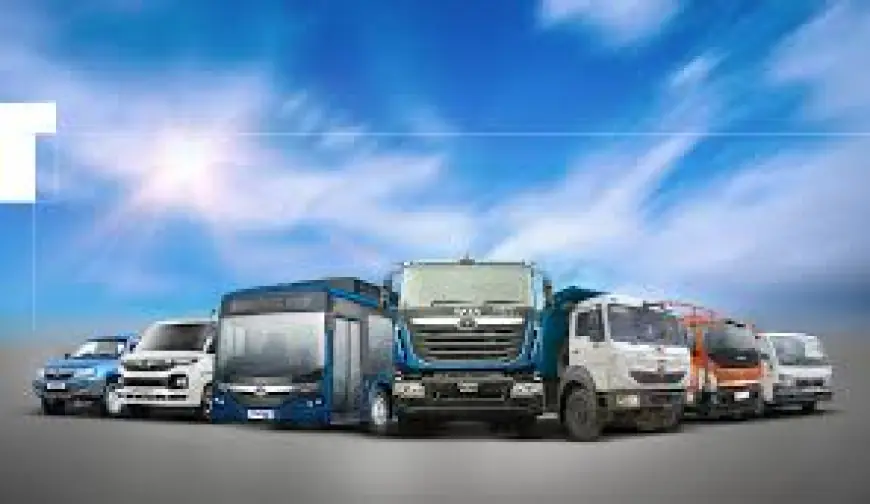Saudi Arabia Commercial Vehicle Market 2030F: Future Trends
Commercial vehicles are integral to supporting construction activities, from transporting building materials to mobilizing heavy equipment across job sites.

The commercial vehicle landscape in Saudi Arabia is undergoing a transformative evolution shaped by Vision 2030, economic diversification efforts, and the integration of digital technology across logistics and mobility sectors. According to industry research, the Saudi Arabia Commercial Vehicle Market was valued at USD 7.81 billion in 2024 and is projected to grow to USD 9.95 billion by 2030, exhibiting a compound annual growth rate (CAGR) of 4.12%. This upward trajectory signals increasing demand for versatile, efficient, and environmentally conscious commercial mobility solutions across the Kingdom.
Emerging Trends in the Saudi Arabia Commercial Vehicle Market
1. Surge in Hybrid Vehicle Adoption
Hybrid commercial vehicles have emerged as a prominent trend, particularly in urban regions such as the Western provinces. These vehicles bridge the gap between conventional internal combustion engine (ICE) models and electric vehicles, delivering a blend of fuel efficiency, reduced emissions, and extended range. Their adaptability makes them ideal for fleet operations that require consistency in performance and coverage over long distances.
2. Digital Telematics and Smart Fleet Management
The adoption of telematics and smart fleet management systems is rapidly transforming operational efficiency. Fleet operators are leveraging real-time tracking, driver behavior analytics, predictive maintenance alerts, and geofencing tools to streamline logistics and reduce costs. These innovations are essential in enhancing safety, optimizing delivery schedules, and minimizing vehicle downtime.
3. Flexible Ownership Models
Subscription-based and leasing models are gaining traction in the market. Startups and SMEs are particularly drawn to these models due to their cost-effectiveness and flexibility. By avoiding high upfront capital investment, businesses can manage fleets more dynamically while also benefiting from bundled services, including insurance, maintenance, and vehicle upgrades.
4. Specialized Vehicles for Niche Sectors
Saudi Arabia's growing service sectors—tourism, healthcare, retail, and cold chain logistics—are creating demand for customized commercial vehicles. Refrigerated vans, mobile medical units, and other specialized models are becoming more prevalent as businesses seek application-specific vehicles to cater to niche operational requirements.
Download Free Sample Report: https://www.techsciresearch.com/sample-report.aspx?cid=1577
Key Market Drivers
1. Vision 2030 and Economic Diversification
The Kingdom's Vision 2030 initiative emphasizes reducing dependency on oil by strengthening sectors such as tourism, retail, entertainment, and logistics. This diversification is increasing the need for varied commercial vehicles suited to the evolving infrastructure and service demands.
2. Infrastructure Development
Massive investments in transportation and urban infrastructure, including road network expansion and smart city projects, are boosting commercial vehicle utility. These developments enhance regional connectivity and drive demand for medium and heavy-duty trucks.
3. Environmental Policies and Sustainability Goals
Environmental regulations aimed at reducing emissions are pushing companies to adopt greener alternatives. Hybrid and electric commercial vehicles are gaining policy support through incentives, government fleet procurement programs, and public-private collaborations.
4. E-commerce Boom and Last-Mile Delivery Growth
The post-pandemic acceleration of e-commerce in Saudi Arabia is reshaping logistics and delivery frameworks. Light commercial vehicles are witnessing increased demand for last-mile delivery solutions, especially in urban regions.
Industry Key Highlights
- The market is segmented by propulsion (ICE, electric, hybrid), vehicle type (light, medium, heavy commercial vehicles), and region.
- Hybrid commercial vehicles saw the fastest growth in 2024, reflecting a transition toward sustainable yet practical transportation solutions.
- The Western region—including Jeddah, Makkah, and Madinah—emerged as the epicenter for hybrid adoption due to better infrastructure and heightened environmental awareness.
- Customized vehicle demand is on the rise, with specialized segments such as mobile healthcare units, food delivery vans, and vocational vehicles expanding rapidly.
- Digitalization in fleet management is not only improving operational efficiency but also enabling compliance with evolving regulatory norms.
Competitive Analysis
The Saudi commercial vehicle market is characterized by strong competition among global and regional players. Key manufacturers are continually innovating product lines, expanding dealership networks, and forming strategic alliances to tap into emerging opportunities.
Major Players Include:
- Toyota Motors Corporation – Known for its durable and fuel-efficient light and medium commercial vehicles widely used across various sectors.
- Isuzu Motors Saudi Arabia Co. Ltd. – A major player in heavy-duty trucks and buses with an extensive service network.
- Hino Motors Limited – Offers reliable trucks equipped with advanced safety and telematics systems.
- Ford Motor Company – Gaining ground in the LCV segment with versatile and modernized vehicle offerings.
- Hyundai Motor Company – Focused on affordability, design, and efficiency in their CV lineup.
- MAN Truck and Bus Middle East and Volvo Trucks Corporation – Dominating in the premium heavy-duty segment.
- Mercedes-Benz Commercial Vehicles KSA – Popular among luxury and municipal fleet buyers.
- Ashok Leyland – Gaining traction in the mid-cost utility vehicle segment.
These companies are investing in hybrid and electric vehicle R&D, expanding after-sales services, and promoting digital innovation to stay competitive.
Future Outlook
The future of Saudi Arabia’s commercial vehicle market is increasingly aligned with sustainability, digitalization, and service-centricity. The hybrid vehicle segment is expected to further expand, supported by ongoing urbanization and infrastructure growth. Meanwhile, electric commercial vehicles, though still nascent, will gain momentum as the national charging infrastructure matures.
Fleet digitalization will remain a cornerstone of operational excellence, offering predictive analytics, cost optimization, and real-time route visibility. Simultaneously, leasing and subscription models will evolve into mainstream ownership formats, especially for startups and small businesses.
Urban development in secondary cities and special economic zones will continue driving vehicle demand across light, medium, and heavy categories. Government policies will further reinforce this trajectory through incentives, sustainability mandates, and smart mobility investments.
10 Benefits of the Research Report
- Comprehensive Market Overview – Detailed analysis of market size, segmentation, and growth trajectory through 2030.
- Emerging Trends Identification – Insights into upcoming technologies, ownership models, and fleet digitization.
- Accurate Forecasting – Data-backed projections that assist in strategic business planning.
- Segment-wise Analysis – Breakdown by propulsion, vehicle type, and regional dynamics.
- Competitive Landscape Mapping – In-depth profiles of leading manufacturers and their strategic initiatives.
- Investment Opportunities – Uncover growth sectors and potential partnerships across the value chain.
- Regulatory Insight – Understand government policies, Vision 2030 alignment, and emission norms.
- Strategic Recommendations – Actionable advice for fleet operators, OEMs, and investors.
- Infrastructure & Mobility Correlation – Analysis of how national infrastructure projects influence CV demand.
- Customer Behavior Trends – Study of ownership preferences, leasing patterns, and post-sale service expectations.
Conclusion
The Saudi Arabia Commercial Vehicle Market is steering toward a smart, efficient, and sustainable future. As Vision 2030 unlocks new economic opportunities and reshapes urban mobility, commercial vehicles are becoming critical enablers of this transformation. The growing preference for hybrid vehicles, the rise of digital fleet solutions, and the diversification of ownership models point toward a market that values innovation, adaptability, and environmental consciousness.
Contact Us-
Mr. Ken Mathews
708 Third Avenue,
Manhattan, NY,
New York – 10017
Tel: +1-646-360-1656
Email: [email protected]
Website: www.techsciresearch.com
What's Your Reaction?
 Like
0
Like
0
 Dislike
0
Dislike
0
 Love
0
Love
0
 Funny
0
Funny
0
 Angry
0
Angry
0
 Sad
0
Sad
0
 Wow
0
Wow
0


















































